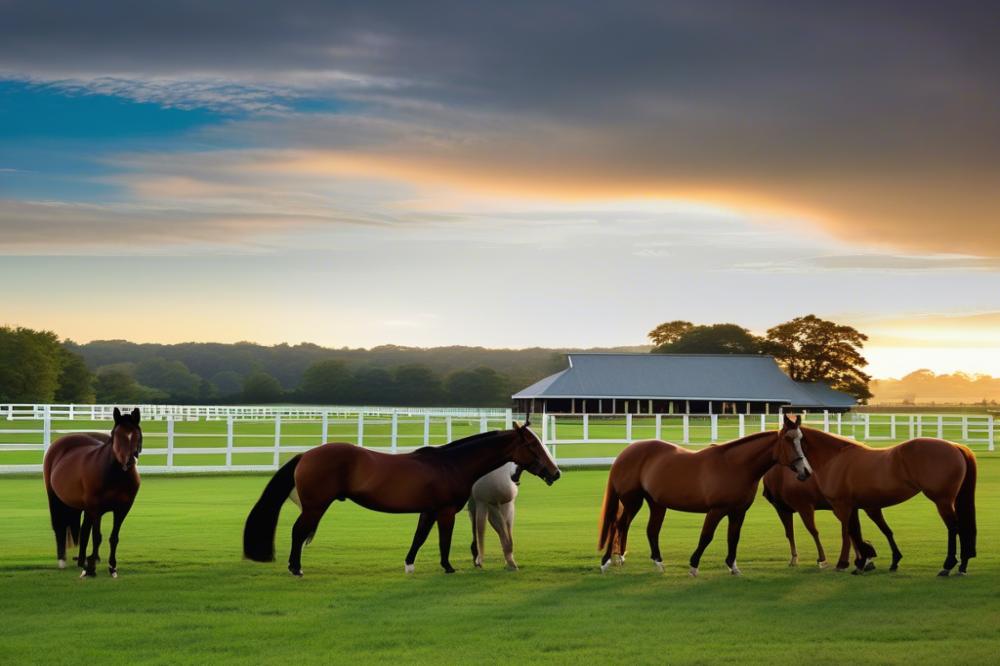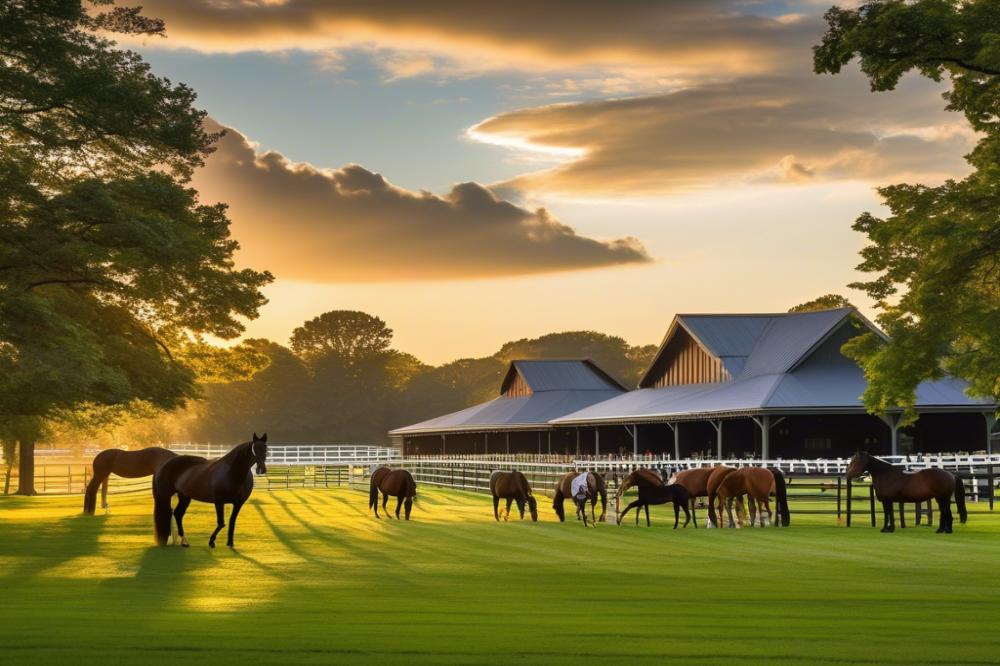Breeding for speed: Insights from Thoroughbred Experts
breeding horses for speed is an intricate and fascinating field. In horse racing, the goal often centers on producing top performers that can dominate the track. Thoroughbred breeding plays a crucial role in achieving this aim. By carefully selecting bloodlines, breeders aim to enhance speed, stamina, and overall athletic ability in the next generation of racehorses.
Speed serves as a critical performance factor in equine athletes. It determines how well a horse can compete against others in races. Breeders and trainers analyze each lineage to predict potential speed capabilities. This predictive effort also considers the horse’s physical traits, training, and racing strategy.
Different factors contribute to a horse’s overall speed. genetics is perhaps the most significant of these factors. Successful racehorses often have ancestors who excelled on the racetrack. Additionally, environmental factors and training regimens play vital roles in shaping a horse’s performance.
The quest for speed does not end with the breeding process. It continues through careful training and development. Experts emphasize the need for a well-rounded approach to horse racing. Breeders aim to create horses that can not only run fast but also maintain that speed over distances. Thus, the breeding process must focus on producing athletes capable of thriving in competitive environments.
In summary, the world of breeding for speed is rich and complex. Thoroughbred breeding combines skill, knowledge, and an understanding of genetics. In doing so, it aims to deliver the next generation of champions on the racetrack.
Understanding Thoroughbred Breeding

Thoroughbred breeding refers to the practice of mating horses to produce offspring that excel in speed and agility, particularly in racing. This method has deep historical roots, tracing back to the 17th century. In England, three foundation sires, known as the Eclipse, Herod, and Matchem, are considered essential to the breed’s creation. Successful horses from these lineages set high standards. Their impact still influences breeding programs today.
Role of Genetics in Speed and Performance
Genetics plays a vital role in determining how fast a horse can run. Every horse inherits traits from its parents, and these inherited characteristics affect its performance. Breeders study these traits closely. They often use techniques like DNA testing to understand genetic backgrounds better. Certain genes associated with speed can be identified. This scientific approach helps in selecting horses with the potential for exceptional racing ability.
Importance of Bloodlines and Pedigree in Breeding Decisions
Bloodlines carry significant weight in the world of horse racing. A horse’s pedigree shows its ancestry, revealing its lineage. This information helps breeders make informed decisions. Horses with proven records in their bloodlines often fetch higher prices. They are seen as having a better chance of succeeding on the racetrack. Notable ancestors can enhance a foal’s value long before it even hits the racetrack.
Breeders analyze past performances of horses in a particular pedigree. They look for patterns that suggest speed potential and stamina. Every race horse has unique genetic traits that may contribute to their performance. Therefore, understanding these traits becomes crucial. Bloodlines are not just historical; they provide insights into what may emerge in the next generation.
The Science of Speed

Understanding the genetics of speed in horses involves exploring specific markers linked to performance. Researchers have identified various genes that can influence how a horse runs. Some genetic variations may enhance a horse’s ability to excel on the racetrack. Through meticulous study, breeders can select horses that possess these advantageous traits.
Conformation plays a vital role in racing performance as well. A horse’s body shape and structure are crucial. Long legs paired with a well-shaped body can contribute to better speed. The angle of a horse’s shoulder, for instance, can affect its stride length. Even the size of the hoof can have an impact on traction and balance during a race.
Specific traits and characteristics further influence how quickly a horse can run. A strong, powerful hindquarter is essential for producing speed. Additionally, temperament matters too. Horses that are calm and focused may perform better than those that are easily distracted. Breath control and lung capacity contribute to endurance, which complements speed over longer distances.
Breeding programs that focus on these factors are crucial in developing high-performing racehorses. Each breeding choice can affect the likelihood of passing on desirable attributes to offspring. Thus, a thorough understanding of genetics, conformation, and specific traits can significantly influence the speed of future champions.
Breeding Strategies for Speed

Experts in horse breeding apply several key strategies when aiming for speed in Thoroughbreds. Choosing the right stallion and mare plays a crucial role in this process. The lineage of each horse holds significant weight. Genetic traits inherited from the parents often determine a horse’s potential for speed.
Stallions known for their racing success are frequently selected. Their performance on the track serves as a reliable indicator of their ability to pass on speed. Mares also have a vital influence. A mare’s own racing history and pedigree contribute to her offspring’s chances of excelling. Understanding bloodlines is essential. This knowledge guides breeders in making informed decisions about pairings.
Breeding specialists often analyze more than just records. They look at physical traits, temperament, and conformation. These factors can greatly influence a horse’s performance. Good conformation allows for more efficient movement, which is vital for speed. The hawk’s angle, limb structure, and overall balance are all considered. A well-structured horse is more likely to perform well.
Moreover, balancing genetics with proper training is important. A horse may have the right genes but still requires expert conditioning. Training regimes should be tailored to develop a horse’s full potential. Races and gallops help build stamina and speed over time. Trainers work closely with breeders to maximize the effectiveness of these programs.
Veterinary care is another aspect that cannot be overlooked. Healthy horses perform better than those with underlying issues. Regular check-ups help identify potential problems early on. They can address any concerns before they affect speed during training or races. Breeding for speed may also involve selecting horses with fewer health issues in their lineage.
The overall goal of breeding is to produce well-rounded horses. Speed is important, but so is the ability to endure races. A focus on balanced breeding produces horses that not only excel in speed but can maintain it over longer distances. The combination of genetics, training, and health creates the foundation for success in the racing world.
Training Techniques to Enhance Speed
Racehorses require specialized training regimens to develop speed. These programs focus on building strength, stamina, and agility. Trainers often utilize different methods to maximize the horse’s potential. Exercises may include interval training, long gallops, or even hill workouts. Each technique serves a specific purpose in improving a horse’s overall performance.
Understanding the bond between breeding and training is crucial. A horse’s genes provide a foundation, but training shapes the athlete. Breeders can select for certain traits, like body structure or temperament. Subsequently, trainers must adapt techniques to highlight these traits. This collaboration ultimately enhances speed on the track.
Specialized training methods play a significant role in achieving maximum speed. For example, using a timing system can track improvements accurately. This allows trainers to adjust workouts based on a horse’s progress. Additionally, proper nutrition is key. A horse’s diet fuels energy levels and promotes recovery after intense sessions.
Incorporating different surfaces for training can also improve speed. Horses may train on dirt tracks, grass, or synthetic surfaces. Each type of surface provides varied resistance, which helps develop muscles differently. This diversity can lead to better performance during races. Trainers often customize these routines to address individual horse needs.
The mental aspect of training should not be forgotten. Horses thrive with positive reinforcement. Encouragement helps build confidence, which can translate into better performance. Understanding each horse’s personality can guide trainers in adapting their methods. This awareness leads to more productive training sessions.
Case Studies and Expert Insights
Interviews with leading breeders and trainers offer a window into the world of Thoroughbred racing. Insights from these experts underscore the challenges and opportunities in breeding for speed. Each breeder has their perspective on what works best. Goals vary, but the desire to produce exceptional racehorses is constant.
Success Stories of Breeding for Speed
Several animals have achieved greatness on the racetrack. Their stories resonate with industry enthusiasts. For instance, one foal, bred from a champion lineage, went on to win multiple major races. Such achievements not only elevate the horse’s value but also influence breeding practices. Successes in speed can shift the focus of breeders toward certain genetics.
Lessons Learned from Past Breeding Successes and Failures
Experience reveals critical lessons in the breeding business. Many breeders have faced setbacks. Poor matches can yield disappointing results. However, those experiences inform future decisions. Learning which traits are desirable helps refine breeding programs. When expectations are not met, adjustments are made. These adaptations contribute to improved breeding strategies over time.
Conversations with trainers showcase the importance of preparation. Understanding a horse’s strengths can enhance its performance. They emphasize the need to nurture a young horse, helping it reach its potential. Preparation is just as crucial as the bloodlines themselves. Trust plays a vital role in the relationship between breeder and trainer. Strong communication ensures everyone is aligned in their goals.
Overall, the journey of breeding for speed is complex and layered. Each story connects to the broader narrative of the industry. Breeders and trainers share in the commitment to produce horses that thrill and inspire. This dedication keeps the passion for racing alive and well.
Final Thoughts on Breeding for Speed
Breeding for speed is a fundamental aspect of the Thoroughbred industry. The legacy of these magnificent horses lies heavily in the genetic choices made by breeders over the years. While physical characteristics certainly matter, the underlying traits passed down through generations play a significant role. Understanding these genetics allows breeders to make informed decisions that can lead to new champions.
This field is constantly evolving. Recent advancements in technology and research are opening new doors for breeding strategies. Insights from experts are more valuable than ever. They highlight the importance of data-driven approaches to selecting sire and dam pairings. Future strategies may incorporate more sophisticated genetic testing, enabling a more precise selection process.
Aspiring breeders should pay attention to expert advice and ongoing research. Learning about the latest developments can enhance their practices and increase their chances of success. Knowledge is a powerful tool in the world of breeding, and those who seek it will find opportunities. Engaging with professional networks also provides a platform for sharing ideas and experiences.
In conclusion, the journey of breeding racehorses is a complex one, filled with challenges and rewards. It requires passion and dedication. Breeders who focus on the nuances of genetics and apply expert insights will stand a better chance of producing elite athletes. The future of Thoroughbred breeding is bright, and those who invest in understanding its intricacies will surely reap the benefits.



